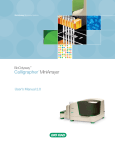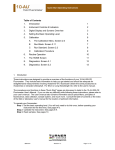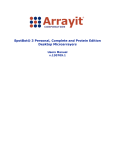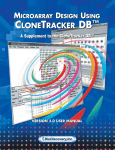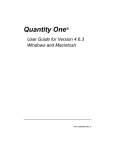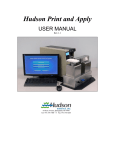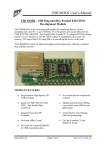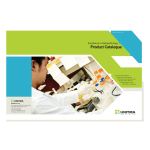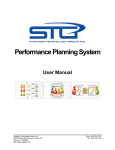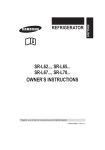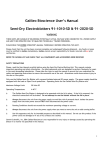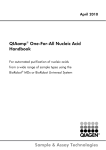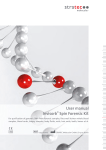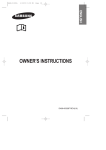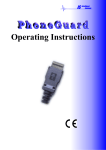Download BioOdyssey™ Calligrapher™ MiniArrayer FAQs - Bio-Rad
Transcript
BioOdyssey™ Calligrapher™ MiniArrayer FAQs Table of Contents: General Instrument Information ........................................................................................................4 What options are available for the Calligrapher? ......................................................................4 Can I use a laptop to run the Calligrapher? ................................................................................4 How much benchspace is required for safe operation of the Calligrapher? ........................4 How do I use the humidity control module?...............................................................................4 If I have the BioOdyssey Calligrapher system with cooling module, how do I adjust the platen temperature? ........................................................................................................................4 What does “communication not established" mean? ..............................................................4 General Printing Questions................................................................................................................5 How should I test my new Calligrapher system? ......................................................................5 How long will it take to print my microarray using the Calligrapher? ...................................5 What is the maximum number of spots that can be printed on a slide? ...............................5 Are there any special adjustments for printing onto FAST slides? .......................................5 Programming Questions.....................................................................................................................5 In the Calligrapher software, what is the difference between a grid and a supergrid? ......5 Can I print an array without using the Plate Librarian™ and/or SpotMapper™ software? 6 How do I program the Calligrapher to print into the wells of 96-well plates? ......................6 Pin Questions .......................................................................................................................................6 What are the differences between quill (Stealth) and solid pins? ..........................................6 What are the differences between MCP™ capillary and solid pins?......................................6 Why should I blot? ..........................................................................................................................6 When should I blot? ........................................................................................................................6 Which pins will be shipped with the Calligrapher? ...................................................................6 Can all TeleChem quill pins be used with the Calligrapher?...................................................6 Can BioOdyssey MCP pins be used with an older Calligrapher model? ..............................6 Can TeleChem pins be used in the current Calligrapher printhead, along with BioOdyssey MCP pins?..................................................................................................................7 Can the BioOdyssey MCP loading tool be used to load TeleChem pins? ............................7 Is the BioOdyssey MCP loading tool required to load the pins? ............................................7 What kind of samples can be printed using the current BioOdyssey MCP pins?...............7 How many samples can I print with the BioOdyssey MCP pins? ...........................................7 Can proteins be printed with the BioOdyssey MCP pins?.......................................................7 What should I consider if I am printing into a 96-well destination plate or onto FAST 16-well slides?..................................................................................................................................7 Can all MCP pins be used with 1,536-well source plates?.......................................................7 Substrate Questions............................................................................................................................7 Will round-bottom or V-bottom PCR plates work as source plates with the Calligrapher?....................................................................................................................................7 What kind of slides do you recommend for use with the Calligrapher? ...............................8 What slides and buffers do you recommend for printing nonmodified 25- to 30-mer oligos?...............................................................................................................................................8 Protein Array Questions .....................................................................................................................8 For protein arrays, can I print raw protein extracts or must I use synthesized protein? ...8 What would you recommend as a standard protocol to print a protein array? ...................8 What is the sensitivity for an ELISA-type assay using a microarray?...................................8 What temperature would you recommend for a protein array print run? .............................8 Do you have a list of publications by researchers printing protein arrays? ........................8 Spot Deposition Questions ................................................................................................................8 Why are some of the spots in my array missing? .....................................................................8 Why do my spots look like donuts?.............................................................................................9 Why do I see inconsistent spot sizes in my membrane array?...............................................9 2 Why am I observing carryover between spots in my array? ...................................................9 Why am I not getting the spot size that the manufacturer states is specific for my pin type? ...........................................................................................................................................9 Software Questions .............................................................................................................................9 If I upgrade to the MCP printhead, will my existing robot files still run? ..............................9 If I install the Calligrapher software, version 2.0, on my computer, will my existing robot files still run?....................................................................................................................................9 I’ve lost the original discs included with my Calligrapher. How can I install the current software version without disc 2?................................................................................................10 Custom Calibration Software Upgrade Questions.......................................................................10 Does my new Calligrapher come precalibrated?.....................................................................10 Can I adjust the Calligrapher calibration settings myself?....................................................10 How do I use the custom calibration software upgrade module to adjust the calibration settings? .........................................................................................................................................10 Will changing the calibration affect my existing protocols? .................................................10 General Maintenance Questions .....................................................................................................10 What are the guidelines for general maintenance of my Calligrapher? ..............................10 List of tech notes available ..........................................................................................................11 3 General Instrument Information What options are available for the Calligrapher? ∑ Humidity control module (HCM) ∑ Cooling module: maintains cooled platen (substrate and source plate area); the Calligrapher system with cooling module includes a refrigerated circulator with digital control and HCM ∑ Custom calibration software upgrade Can I use a laptop to run the Calligrapher? No. We strongly recommend that you purchase a dedicated PC desktop computer, as detailed in the product literature and BioOdyssey™ Calligrapher™ MiniArrayer User’s Manual 2.0. How much benchspace is required for safe operation of the Calligrapher? The Calligrapher’s footprint is 52.1 x 55 x 39.4 cm; however, you should allow for at least 5 cm clearance behind the instrument. The Calligrapher door opens upwards which requires approximately 30 cm clearance above the instrument. The power switch is on the right side, so allow at least 5 cm clearance on the right side in order to access the power switch. How do I use the humidity control module? ∑ Access the Humidity Control window in the software, and set the desired humidity level → When printing oligos or any sample WITHOUT cooling, we recommend 55% → When printing proteins or any sample WITH cooling, we recommend 40% ∑ When setting the humidity, please allow 15–30 minutes for the humidity to reach the set point, and leave this on for the duration of the run If I have the BioOdyssey Calligrapher system with cooling module, how do I adjust the platen temperature? ∑ Temperature adjustments are made on the refrigerated circulator → The software does not include a temperature control feature; the Control Panel and Array Monitor windows display a chamber temperature and an estimated temperature for the cooled platen → The chamber temperature is a real measurement taken by a sensor located within the chamber, but not on the platen → To calculate the platen temperature, the following equation can be used: y = 1.29x – 8.6322 ∑ When using the cooling module, set the refrigerated circulator at 0°C as recommended → This setting will provide a platen temperature of 10–15°C, which is suitable for most protein applications → Allow approximately 45–60 minutes for cooling to equilibrate, depending on the difference between room temperature and the desired temperature ∑ The humidity should be set at 40% to ensure adequate dehumidification Note: We recommend that you DO NOT modify the humidity or cooling module settings in the middle of a run; please establish the constant environment at the beginning of the run. What does “communication not established" mean? This indicates that the Calligrapher is not turned on or recognized by the software. First ensure that the instrument has been turned on. If not, turn it on and go to the Setup menu > select “Set Ports” > click on “Search for COM Ports” followed by “Establish Communication.” If this fails, check that you have followed the installation guide and installed the hardware, software, and drivers correctly. 4 General Printing Questions How should I test my new Calligrapher system? To perform a test run, we recommend that you use food coloring diluted 1/10 in PBS containing 0.1% Tween 20. You can also dilute the food coloring in a print buffer of your choice (for example, 3xSSC). You can then design your test array to print onto slides (Corning UltraGAPS or FAST glass slides), membranes, or into the wells of a 96-well plate, depending upon your final sample choice. For the initial test, we recommend that you start with membranes or plain glass slides. Note: Spot morphology on plain glass slides will not be identical to that on microarray substrates; the spots may be larger and have irregular shapes. If you print on membranes, a plate and membrane adaptor (catalog #169-2004) is shipped with the Calligrapher system. The plate and membrane adaptor keeps the OmniTray (Nunc catalog #242811) in place. The OmniTray protects the membrane from moisture that may accumulate on the platen. (The OmniTray height value was taken into account during calibration of the Calligrapher system.) If you are performing an initial test run, we recommend that you use the solid MCP310S pin or the practice/calibration pins provided with the Calligrapher system and that you use the default parameters. Once you have assessed your results, begin altering parameters as necessary. How long will it take to print my microarray using the Calligrapher? The length of the print run will depend upon the number of samples and replicates, blotting options, type and quantity of pins, type of source plate, and MAINLY the wash parameters. With the Calligrapher it will take less than 2 hours to print 384 spots onto 16 slides using 8 pins with a wash program designed for minimal to no contamination. It will take approximately 2 hours and 45 minutes to print a full 96-well plate with a single pin with 2 replicates, a 10 x 10 spot array, and 2 wash cycles. Note: Contact Technical Support at 1-800-424-6723 for more specific information. What is the maximum number of spots that can be printed on a slide? There is no substantial limitation on the number of spots that can be printed. The parameters in the software can be adjusted to print more than 20,000 spots; however, this might take hours to days to print because the printhead holds just 8 pins. The Calligrapher system was designed for printing <5000 spots, and can easily print ~1000 spots. You will need to set up the parameters while defining the arraying run to calculate the number of spots you require. Are there any special adjustments for printing onto FAST slides? Yes. When printing onto FAST slides (or other nitrocellulose-coated slides) adjust the Z-axis height in the Options window to –0.5. If results are not satisfactory, adjust the Z-axis height to –1.0. Note: Calligrapher software, version 2.0, includes predefined array protocols for FAST slide pad formats. To locate them, select “Define Arraying” from the Arraying menu > select “Open an existing run” > select the “Predefined Protocols” file from the Default folder. Programming Questions In the Calligrapher software, what is the difference between a grid and a supergrid? ∑ A grid is generated by the printing of a single pin on the substrate (a slide, membrane, or 96-well plate) ∑ A supergrid is a group of grids printed on the substrate by all the pins loaded into the printhead (maximum of 8 pins) 5 Can I print an array without using the Plate Librarian™ and/or SpotMapper™ software? Yes. The Calligrapher will print a run directly from the vrk/prg files without having to go through the Plate Librarian or SpotMapper tools. There is no special error message or warning. How do I program the Calligrapher to print into the wells of 96-well plates? This programming is done when you define your array parameters. From the Arraying menu select “Define Arraying” > select “Create new arraying run” > select “96 Well Plates” as your substrate of choice in the Substrates tab. ∑ In the Grid Layout window, enter the number of samples that you wish to print (note that the basic window allows up to 81 samples to be printed into a single well) ∑ Replicate the grids 12 times in the “X” direction ∑ Open the Advanced window; under Replicate Supergrids, enter 8 in the “Y” column This layout provides a grid (up to 81 samples) in each well of a 96-well plate. Note: When printing into a 96-well plate you can only use up to 2 pins because of the spacing of the wells in the 96-well plates. Pin Questions What are the differences between quill (Stealth) and solid pins? Solid pins require re-dipping after 1–2 spots, while quill pins have a sample reservoir that, when filled with sample, can deposit tens to hundreds of spots/dip. What are the differences between MCP™ capillary and solid pins? The MCP100 and MCP360 capillary pins are designed for repetitive printing. The capillary design of the MCP100 and MCP360 pins reduces sample evaporation within the pin, providing more consistent print runs and reducing misfire (missing spot) rate. The MCP310S solid pins are used for “dip and print” arrays. Why should I blot? Blotting is used with any type of pin that is used for repetitive printing to eliminate excess sample on the outside of the pin and to prime the pin. This results in more consistent spot morphology. When should I blot? Blot when using capillary or quill pins; we do not recommend blotting when using solid pins because you will lose your sample. We recommend that you blot 5–10 times before printing onto plain glass slides cleaned with ethanol. Which pins will be shipped with the Calligrapher? We will ship one pin of each type; one each of MCP100 and MCP360 capillary pins and one MCP310S solid pin. Can all TeleChem quill pins be used with the Calligrapher? If your Calligrapher was designed for use with the TeleChem pins (prior to May 2008), then the SMP3 pins were used in factory calibration. However, different-sized TeleChem Stealth Micro Spotting (SMP) pins do fit in the printhead, but care should be taken when programming. Note: If you wish to use pins other than the SMP3 pins, adjust the spot distance in the Advanced menu. Can BioOdyssey MCP pins be used with an older Calligrapher model? No. MCP pins are not backwards compatible. A current Calligrapher model with the MCP printhead installed is required. If you have a Calligrapher model purchased before May 2008, you can purchase the BioOdyssey Calligrapher MCP printhead upgrade (catalog #169-2080), which includes installation. 6 Can TeleChem pins be used in the current Calligrapher printhead, along with BioOdyssey MCP pins? No. Once a current Calligrapher model has been purchased, or an existing Calligrapher has been upgraded to utilize the MCP printhead, the TeleChem pins will no longer be compatible. Can the BioOdyssey MCP loading tool be used to load TeleChem pins? No. The MCP loading tool is not backwards compatible; it has been specifically designed to assist with loading and unloading the BioOdyssey MCP pins. Is the BioOdyssey MCP loading tool required to load the pins? No. If the MCP loading tool is not purchased, forceps can be used to handle the MCP pins. Refer to the BioOdyssey™ Calligrapher™ MiniArrayer User’s Manual 2.0. What kind of samples can be printed using the current BioOdyssey MCP pins? The BioOdyssey MCP pins can be used to print any soluble sample, from proteins and cell lysates to nucleic acids, oligos, and RNAi. MCP100 capillary pins, which are smaller, are recommended for printing low-viscosity samples, such as DNA, oligos, and RNA. The larger MCP360 capillary and MCP310S solid pins are used with higher-viscosity samples, such as proteins and cell lysates. Note: The choice of pin is dependent upon the spot size that is required; all BioOdyssey MCP pins can print many different samples. How many samples can I print with the BioOdyssey MCP pins? MCP100 pins, which print a smaller spot size (100 µm), are recommended for high-density arrays (≥1000 spots). MCP360 or MCP310S pins, which print a larger spot size (~400 µm), are recommended for low-density arrays (≤1000 spots). Can proteins be printed with the BioOdyssey MCP pins? Yes. Proteins can be printed with all MCP pins. In fact, the larger MCP360 capillary and MCP310S solid pins have been optimized to print protein samples. What should I consider if I am printing into a 96-well destination plate or onto FAST 16-well slides? The choice of pin depends on the spot diameter and density of the array being printed. When printing into a 96-well destination plate and printing low-density arrays, the MCP360 capillary pin is optimal. For FAST surfaces, slides, pad slides, or 16-well slides, the MCP310S solid pin is optimal, but the MCP360 capillary pin can also be used. Note: The software now has predefined protocols for FAST slides, with the array parameters already defined. When printing onto these types of substrates, 1–2 pins are required. Can all MCP pins be used with 1,536-well source plates? No. Only the MCP100 pins will function properly with this plate. Substrate Questions Will round-bottom or V-bottom PCR plates work as source plates with the Calligrapher? No. These plates are not recommended for microarray use. The plates are easily bendable (unlike Costar 96- and 384-well plates, which are made of polypropylene and firm) and when one is placed on the source plate holder the bottom left corner is somewhat "lifted," and does not lie flat against the platen (spring holder holds it snug, thus warping the plate). Note: With the V-bottom-shaped wells, the pins must be accurately centered to reach the small sample volume or the pin hits the well walls. Also, since the wells are V-shaped, the area to work with is limited. 7 What kind of slides do you recommend for use with the Calligrapher? The Calligrapher can use any standard slide. If you are using a 25 x 75 mm slide, note that the dimensions are slightly different than a 1 x 3” slide. There are so many different applications that it is difficult to provide a complete list. Many companies (Greiner, Nunc, Whatman) are now making slides that are subdivided into individual wells─the Calligrapher can print into those wells. Note: If you are using a nonstandard-sized slide, the Custom Calibration option provides you with the ability to set the instrument to those specifications. What slides and buffers do you recommend for printing nonmodified 25- to 30-mer oligos? The slides that are most frequently used are Corning slides, specific for short oligos (including 20mers). Corning also recommends Epoxide-coated slides in 150 mM sodium phosphate buffer, pH 8.5, containing 0.005% SDS. Protein Array Questions For protein arrays, can I print raw protein extracts or must I use synthesized protein? You can print either; the Calligrapher will spot any soluble molecule onto a surface. However, we encourage you to take time to review the literature and optimize the parameters for spotting. What would you recommend as a standard protocol to print a protein array? Refer to tech note #5512, “How to Print Protein Microarrays With the BioOdyssey™ Calligrapher™ MiniArrayer,” available for download at www.bio-rad.com. Also download or view a FLASH movie on how to print protein arrays from our website: www.bio-rad.com > select Life Science Research > Microarray Products > Learn About Microarrays. What is the sensitivity for an ELISA-type assay using a microarray? This will vary depending upon many factors. In general, with the proper antibody sets, as low as fmol amounts of protein can be detected. What temperature would you recommend for a protein array print run? We recommend setting the refrigerated circulator to 0°C, which will cool the Calligrapher to ~10°C. If you are printing proteins denatured with SDS, guanidine, or other detergent you would not want to use the refrigerated circulator UNLESS you are planning on long print runs. If print runs are longer than 3 hours, then use it to maintain a temperature of 22–24°C (to keep everything solubilized), and reduce the amount of evaporation from your source plate. This will maintain the concentrations of your denatured proteins. Do you have a list of publications by researchers printing protein arrays? See the tech notes available for download on our website, www.bio-rad.com. Spot Deposition Questions Why are some of the spots in my array missing? The missing spots can be a result of a clogged pin, or dust/debris in the printhead. Make sure the pins are cleaned following the manufacturer’s directions. Dust or solution residue may accumulate in the printhead holes, causing the pins to “stick” in the printhead. This will result in misfiring or missing spots. Refer to “General Maintenance Instructions” to clean the printhead. 8 Why do my spots look like donuts? This effect is due to several causes. The most common cause is inadequate humidity at the platen. The humidity in the Calligrapher chamber must be regulated for optimal spot morphology. For many DNA applications we recommend a relative humidity setting at 55%; for temperaturesensitive samples, such as proteins or peptides, we recommend 40% relative humidity with the cooling module set to 0°C. You may also consider adjusting the dwell time and Z-height depending upon the sample and the substrate type. Why do I see inconsistent spot sizes in my membrane array? Several situations can lead to inconsistent spots in your array, including inadequate maintenance of pins, inefficient pin cleaning, an uneven substrate surface, or printing parameters that have not been adequately optimized. ∑ To increase the consistency of spot size, clean quill pins prior to use and then apply a prewash (with the same conditions as your wash steps) prior to printing ∑ If printing on membranes, try adhering them with glue or tape to the OmniTray, which will reduce the fluctuation in the substrate surface ∑ Adjust the printing parameters as follows: set the approach speed at 10 mm/sec, and the dwell time from 50 ms to 5 ms; this minimizes the amount of “wicking” of the sample from the pins onto the membrane and produces more consistent spots Note: Adjust the Z-down height so that the pin barely touches the membrane to avoid “overwicking” onto the membrane. Why am I observing carryover between spots in my array? In most cases, sample carryover is a result of inadequate washing of the pins between dips. If you are printing proteins, try using 10% ethanol and 0.1% Tween in the passive wash bath. Refer to tech note # 5310, “Reducing Carryover Contamination During Microarray Printing,” available for download at www.bio-rad.com. Note: ONLY use water in the flow-through bath. REMEMBER: The MCP pins are cleaned onboard by selecting the WASH PINS icon. No extraneous cleaning, sonication, or special cleaner is required. Why am I not getting the spot size that the manufacturer states is specific for my pin type? When reviewing the expected spot size of a pin, be careful to note the sample and buffer used to validate these recommendations. The consistency and viscosity of the sample and the substrate surface can have a significant effect on the spot size printed. For example, with TeleChem SMP3 pins a 100 µm spot is expected; when printing oligos in 3xSSC buffer onto a Corning UltraGAPS glass slide a 130 µm spot is expected. On membranes or plain glass slides the spots will tend to spread and appear larger. Software Questions If I upgrade to the MCP printhead, will my existing robot files still run? No. However, reprogramming should be easy, since the default parameters have been extensively tested so no change is necessary, and the application software is still the same. If I install the Calligrapher software, version 2.0, on my computer, will my existing robot files still run? Yes. In the Define Arraying Selection Dialog, select “Open an existing run.” Browse to the BioOdyssey Calligrapher 1.0 folder and then your User file to select your run. 9 I’ve lost the original discs included with my Calligrapher. How can I install the current software version without disc 2? Send the serial number of your instrument (found on the back panel; for example, BR0119) along with your contact information to [email protected]. You will receive an email with a file and instructions to install the software. Custom Calibration Software Upgrade Questions Does my new Calligrapher come precalibrated? Yes. The Calligrapher comes precalibrated from manufacturing and is optimized with default settings that are applicable for many frequently used applications. Can I adjust the Calligrapher calibration settings myself? Yes. You can adjust the calibration settings if you purchase the custom calibration software upgrade (catalog #169-2070) for older Calligrapher systems, or the MCP custom calibration software upgrade (catalog #169-2071) for current Calligrapher systems. The package will include: ∑ Training (either through a webinar or on-site visit) ∑ 2 calibration pins ∑ Custom Calibration User Manual ∑ Certificate of successful completion of training With the activation of the Custom Calibration option, you can adjust source plate, slide, vacuum, wash, blot, membrane, and 96-well destination plate parameters. How do I use the custom calibration software upgrade module to adjust the calibration settings? The parameters are changed in the array parameter windows: select “Define Arraying” from the Arraying menu > choose “Create new arraying run” > select “Modify Calibration” in the Substrates tab to access the calibration settings. This requires activation of the Custom Calibration option; with this option you can adjust source plate, slide, vacuum, wash, blot, membrane, and 96-well destination plate parameters. Will changing the calibration affect my existing protocols? No. Each calibration file is specific to the defined arraying protocol. If you wish to use the modified calibration settings again, you must open this specific array protocol (.par file). If you create a new print array run, the calibration parameters will default back to the original factory calibration values. This is a safety feature to protect the Calligrapher from damage. General Maintenance Questions What are the guidelines for general maintenance of my Calligrapher? ∑ Ensure that you do not run the humidity control module (HCM) when the desiccant is pink; the desiccant must always be BLUE → Refer to the BioOdyssey™ Calligrapher™ MiniArrayer User’s Manual 2.0 for instructions on changing the desiccant Note: Desiccant will turn pink more rapidly if used with the cooling module. ∑ The HCM contains a filter (catalog #169-2013) used in adding humidity to the Calligrapher; we recommend that this filter be changed every 3–6 months → Instructions on how to change the filter are found in the User’s Manual ∑ Clean pins are essential to the performance of the Calligrapher → If TeleChem pins are used, clean them in a sonicator before each use following the manufacturer’s recommendations for cleaning and maintenance → MCP pins are cleaned onboard by selecting the WASH PINS icon; no extraneous cleaning, sonication, or special cleaner is required → For more information, please follow the recommended maintenance instructions detailed in the User’s Manual 10 ∑ To clean the printhead, use the Load Pins feature in the Calligrapher software to bring the printhead to the front of the platen, place a tissue below it and flush with 70% ethanol, then use an interdental brush to clean the holes in the printhead; use compressed air to "blow-dry" the printhead or air-dry the printhead List of tech notes available Bulletin # Title 5308 DNA Microarrays: Optimization of Fabrication Parameters and Control Plate Design 5309 Demonstration of Superior Printing Accuracy by the BioOdyssey™ Calligrapher™ MiniArrayer 5310 Reducing Carryover Contamination During Microarray Printing 5392 Genotyping by Arrayed Primer Extension (APEX) Using the BioOdyssey™ Calligrapher™ MiniArrayer 5403 Cooling Characteristics of the BioOdyssey™ Calligrapher™ Cooling Module 5436 Using the Molecular Imager PharosFX™ System to Image Arrays Printed With the BioOdyssey™ Calligrapher™ MiniArrayer 5437 BioOdyssey™ Calligrapher™ MiniArrayer: Screening for Gene Silencing 5480 Proteomic Analysis of Tumor Biomarkers in Human Clinical Specimens Using the BioOdyssey™ Calligrapher™ MiniArrayer 5512 How to Print Protein Microarrays With the BioOdyssey™ Calligrapher™ MiniArrayer 5534 Qualification of Microarrayers for Clinical Research: Results From Testing of the BioOdyssey™ Calligrapher™ MiniArrayer 5559 A Demonstration of the Accuracy and Precision of BioOdyssey™ MCP™ Pins Used With the BioOdyssey™ Calligrapher™ MiniArrayer 5562 Using the BioOdyssey™ Calligrapher™ MiniArrayer to Form Immobilized Protein Microarrays on Surface-Modified Glass Substrates 5577 Using the BioOdyssey™ Calligrapher™ MiniArrayer to Form a Polymer Array for Studying Cell-Surface Interactions 5599 Reverse Transfection of Mammalian Cells for Functional Screening: Results from Testing the BioOdyssey™ Calligrapher™ MiniArrayer ® Costar and UltraGAPS are trademarks of Corning Incorporated. FAST is a trademark of Schleicher & Schuell BioScience, Inc. Stealth is a trademark of TeleChem International, Inc. Tween is a trademark of ICI Americas Inc. Certain arrays and/or the method of preparation, analysis, or use may be covered by patents or other intellectual property rights owned by third parties. 11











